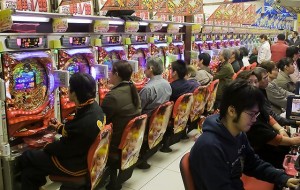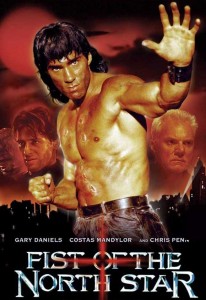Do People Hate Pachinko?
 Okay, people, we’re taking a little bit of a break from our usual anime and anime-inspired topics for a little bit in order to dive a little bit into Japanese culture! I promise that I’ve got plenty of anime-themed posts for you to enjoy (including, but not limited to, a review of “Kiznaiver”, the new anime from the folks behind “Kill La Kill”, and a multi-part retrospective of the “Persona” franchise), but for now I’d like to focus on something a bit different which I regardless find quite interesting, and somewhat relevant to our interests. If you’re strictly interested in my anime thoughts, then feel free to stop reading and wait for my next article, but if you’re fascinated by Japanese culture, then keep on reading! In particular, we’re going to be talking about pachinko machines, which have been a staple of Japanese arcades since the 1920s and have become a big part of the country’s identity, with entire pachinko parlors popping up in numerous cities hosting nothing but dozens upon dozens of pachinko machines. Since gambling, in most of its forms, is strictly prohibited in Japan, pachinko is the closest that most people get to real gambling. It’s actually an ingenious system that has been created by someone deserving of a whole lot more credit than they actually got – when you play pachinko, you earn tickets that you can exchange for prizes. Next to most parlors are entirely separate businesses that will buy those prizes back for cash, so as a result you’re pretty much gambling without breaking any of Japan’s strict laws. Brilliant!
Okay, people, we’re taking a little bit of a break from our usual anime and anime-inspired topics for a little bit in order to dive a little bit into Japanese culture! I promise that I’ve got plenty of anime-themed posts for you to enjoy (including, but not limited to, a review of “Kiznaiver”, the new anime from the folks behind “Kill La Kill”, and a multi-part retrospective of the “Persona” franchise), but for now I’d like to focus on something a bit different which I regardless find quite interesting, and somewhat relevant to our interests. If you’re strictly interested in my anime thoughts, then feel free to stop reading and wait for my next article, but if you’re fascinated by Japanese culture, then keep on reading! In particular, we’re going to be talking about pachinko machines, which have been a staple of Japanese arcades since the 1920s and have become a big part of the country’s identity, with entire pachinko parlors popping up in numerous cities hosting nothing but dozens upon dozens of pachinko machines. Since gambling, in most of its forms, is strictly prohibited in Japan, pachinko is the closest that most people get to real gambling. It’s actually an ingenious system that has been created by someone deserving of a whole lot more credit than they actually got – when you play pachinko, you earn tickets that you can exchange for prizes. Next to most parlors are entirely separate businesses that will buy those prizes back for cash, so as a result you’re pretty much gambling without breaking any of Japan’s strict laws. Brilliant!
But if you’ve been on the Internet… Well, at all in the last couple of years, you might have seen a lot of backlash towards pachinko machines. The announcement of pachinko adaptations of beloved franchises such as “King of Fighters”, “Silent Hill” and “Metal Gear Solid” was met with an uproar among the fan community even though the overwhelming majority of them will never even get to play them, since pachinko is practically non-existent outside of Japan. Controversy after controversy surrounding the announcement of Pachinko machines happened, and even if we put that aside, there seems to be hardly a good word about them on the Internet. Gaijin Goomba – a popular YouTuber whose whole shtick is that he’s intimately familiar with Japanese culture, seemed utterly flabbergasted by pachinko. But why is that? Why all the hate for pachinko when traditional Western gambling doesn’t receive anywhere near this much hate? I mean, sure, there’s still people who go all “slot machines suck your soul and online gambling is the Devil”, but for the most part people seem to be pretty okay with it, especially if we take into consideration its excellent online casino reviews. So why do people hate pachinko?
Well, I asked a couple of my Japanese friends, and the truth is… Drumroll, please… They don’t. Not in Japan, at least. In Japan, people regard pachinko more or less in the same vein that Westerners regard their own gambling. Keep in mind that there is a bit of a generational gap – while in the West gambling is enjoyed by people of all ages, in Japan pachinko is mostly played by older people, which is a big part of the reason why many developers try to push machines bearing the licenses of franchises that appeal to the 20-25 demographic, like “Metal Gear Solid”. And that’s another part – to many Western fans, the existence of a pachinko machine means that the core series suffers. And the worst part is that they’re usually right. Konami, the publisher behind the aforementioned “Metal Gear Solid” and “Silent Hill”, had announced not too long ago that they would cease development of any console titles in favor of pachinko machines, since they cost less to make and as such are more profitable. And while they appear to have backed down on that decision, at the time it truly angered many fans of their franchises, including me. My point is that the hatred isn’t really directed towards the pachinko machines themselves, more towards Konami (and other developers) and their decision to prioritize them over more substantial experiences. It’s like hating on a younger sibling who receives all the affection – we’re not really hating the sibling, just the fact that they get all the love. I hope that clears at least some of it up, and if you enjoyed my little dive into a tiny part of Japan’s culture, then I wouldn’t mind doing it again sometime! And if you didn’t, then stay tuned – we’ll be back to our regularly scheduled programming next time!

 Attack on Titan. Higurashi No Naku Koro Ni. DragonBall. Three beloved anime series that many consider to be among the best. You know what else connects them? All three were adapted into live action movies, and all three (well, five, technically – “Attack on Titan” and “Higurashi” were split into two parts) of those movies were absolute garbage. “The Guyver”, “Devilman”, “Hokuto no Ken”, “Usagi Drop” and many, many, many more examples released over the years just continue to prove, over and over again, that neither Hollywood nor Japanese filmmakers have any idea how to take an anime series and adapt it into live action properly. I mean, sure, there have been a handful of successes, such as “Death Note” and “Ruroni Kenshin”, but those are very few and very far in between. And with “Ghost in the Shell”, “Akira” and the
Attack on Titan. Higurashi No Naku Koro Ni. DragonBall. Three beloved anime series that many consider to be among the best. You know what else connects them? All three were adapted into live action movies, and all three (well, five, technically – “Attack on Titan” and “Higurashi” were split into two parts) of those movies were absolute garbage. “The Guyver”, “Devilman”, “Hokuto no Ken”, “Usagi Drop” and many, many, many more examples released over the years just continue to prove, over and over again, that neither Hollywood nor Japanese filmmakers have any idea how to take an anime series and adapt it into live action properly. I mean, sure, there have been a handful of successes, such as “Death Note” and “Ruroni Kenshin”, but those are very few and very far in between. And with “Ghost in the Shell”, “Akira” and the